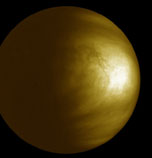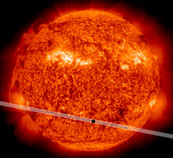
|
Astronaut
An astronaut is a person who travels, works, and lives in space. The Space Shuttle has many astronauts working together.
|

|
Aurora
Auroras are bright, colorful lights we see in the night sky. The light from an aurora moves like a big, flowing curtain. Most of the time, we see auroras near Earth's North and South Poles.
|
|

|
Corona
The corona is the Sun's atmosphere. We see the corona around the Sun during a total solar eclipse. The corona is thin, but very, very hot!
|
|

|
Coronal Mass Ejections
Coronal mass ejections are big eruptions coming off the Sun. Particles shoot out from the Sun.
Sometimes, but not very often, they head toward Earth and can cause our satellites to stop working.
|

|
Convection Zone
The convection zone is the part of the Sun where hot gases bubble like boiling water in a pot. Energy moves from the core of the Sun out through the convection zone and beyond.
|

|
Cycle
A cycle is something that happens over and over, like day and night. A year is also a cycle. Your birthday is on a cycle-it happens every year on the same day! A cycle is a pattern that repeats.
|

|
Magnetosphere
The magnetosphere is an invisible, magnetic shield around Earth that protects us from the solar wind. The solar wind is powerful and can change the shape of Earth's magnetosphere.
|

|
Photosphere
The photosphere is the part of the Sun that we can see with a solar telescope or other special instrument. We also call the photosphere the Sun's surface. But the Sun is not solid-it is a giant ball of hot gases. Remember, NEVER look directly at the Sun. You can really hurt your eyes!
|

|
Satellite
A satellite is a free-flying object that orbits Earth or another body in space.
There are many satellites around Earth. Satellites send us information about Earth, the Sun and space.
|

|
Solar Maximum
Solar maximum is when the Sun is the most active. We see lots of solar flares,
sunspots and magnetic storms on the Sun during solar maximum.
|

|
Solar Minimum
Solar minimum is when the Sun is not very active. During solar minimum, we see fewer flares, sunspots and magnetic storms.
|

|
Solar Wind
The solar wind always flows from the Sun. The solar wind travels very, very fast.
|

|
Star
A star is an object that makes energy. It gives off light and heat.
The Sun that we see everyday is our closest star. The Sun is always shining somewhere on Earth!
|

|
Sunspot
A sunspot is a spot on the Sun that is darker and cooler than the rest of the Sun. Sunspots are big magnetic storms on the Sun. Sunspots are often in pairs. They can be very big-as big as our Earth!
|

|
Venus
Venus is one of the nine planets in our solar system. It is the second planet out from the Sun. (Remember, we are the third planet out from the Sun!) Venus is smaller than Earth. Venus is very, very hot and dry. Sometimes you can see Venus in the early evening or early morning. It is a very bright planet.
|

|
Venus Transit
June 8th, 2004 is a very special day! On that day Venus will be between us on
Earth and the Sun in a very special place. This does not happen very often.
From Earth we will see Venus in its orbit around the Sun. Using special
telescopes we will be able to watch Venus move slowly across the Sun. It will be very exciting!
|

